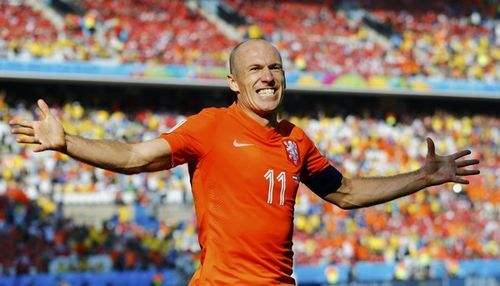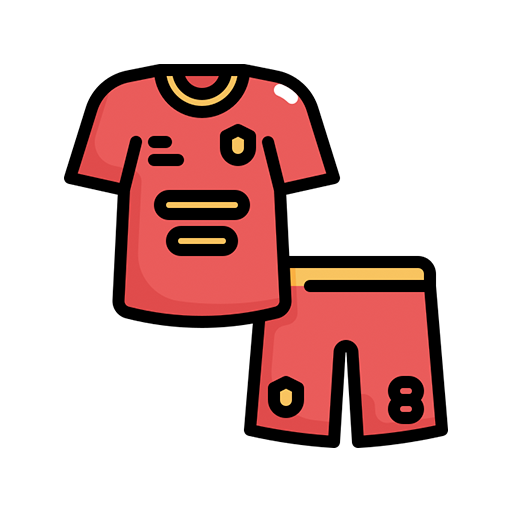
A True Dutch Football Fan Shares the Best Lineup in Dutch Football History
Share
The Netherlands has produced numerous football superstars throughout history, especially in the attacking and midfield positions, with many world-class players and even some legendary superstars who could be considered as quasi-kings of the sport. Although they may not produce as many defensive stars as Italy, the Netherlands has still contributed a significant number of high-quality defenders throughout their history.
From the rise of the Johan Cruyff era in the 1970s, which has now spanned over 60 years, through the golden eras of the "Three Musketeers," "Total Football," "Van Basten," and "Three Sticks," what does the best lineup in Dutch football history look like?
In my opinion, many of the lineups circulating on the internet as the best in Dutch football history are laughable and show a complete lack of understanding of Dutch football history. How can players like Frank de Boer, who are nowhere near the required level, be considered for the best lineup?
Let me, a die-hard Dutch football fan who has watched every golden era (via video and live broadcasts), tell you about the best lineup.
We'll use the most balanced 4-2-3-1 formation, taking into account individual abilities and national team performances when selecting players.
Let's get into the detailed introduction:

Center Forward: Marco van Basten
Widely regarded as the greatest center forward in European history, van Basten has been recognized by numerous authoritative sources such as French Football, UEFA, British 442, and IFFHS, among others, often being able to outscore the German goal-scoring machine Gerd Muller in these rankings.
Don't forget that he achieved the impressive feat of winning three Ballon d'Or awards and one FIFA World Player of the Year award, all before the age of 28.
Van Basten was the template for an all-around center forward, acting as a pivot, displaying exceptional ball control, intelligent positioning, shooting accuracy, and the ability to play on the flanks and drop back to organize the attack. He was the representative figure of the Milan dynasty and the shining star of the Netherlands' victorious 1988 European Championship campaign. Without a doubt, he is the first-choice starter as a center forward.

Left Winger: Johan Cruyff
Widely regarded as the greatest European football player in history, Cruyff has been recognized as the best player in Europe by IFFHS in 1999 and is ranked as the second-best player in the world's history, only behind Pelé. In 1999, he was ranked third in a poll of the century's greatest players by dozens of Ballon d'Or winners invited by France Football, behind only Pelé and Maradona. In 2004, he was named the best European player in UEFA's official magazine "Champions" on the occasion of UEFA's 50th-anniversary celebration.
As the representative figure of the Ajax dynasty and the king of the Netherlands in the 1970s, Cruyff's pure winger abilities were not inferior to the legendary winger Robben. However, he possessed a unique ability to penetrate through the middle, as well as exceptional ball control and organizing skills that Robben could not match. He was a super free-roaming forward, a European football king, and was just one step away from claiming the title of the second generation's football king in the 1974 World Cup.

Attacking Midfielder/Shadow Striker: Ruud Gullit
Gullit's physical qualities are among the best in football history, representing the perfect combination of a white man's large frame and tremendous strength and a black man's explosive power and speed. He is the epitome of an all-around footballer and can play at a world-class level in both midfield and forward positions.
Just imagine a tall and agile player around 6'3" with top-notch speed, explosive power, and agility, who can be a nightmare for any defender. Even when Gullit was not in top form, he could easily overpower many defenders with his sheer physicality.
Gullit was also one of the famous Dutch "Three Musketeers," a representative figure of the Milan dynasty, and the captain of the 1988 European Championship-winning team, further proving his worth as the first-choice attacking midfielder or shadow striker in the best Dutch football lineup.

Right Winger: Arjen Robben
Robben is a historical-level winger and the representative of the inside-cutting winger style. His explosive speed and inside-cutting shot are both at a historical level. Unfortunately, he was plagued by injuries throughout his career, which ultimately affected his ranking in personal honors such as the Ballon d'Or. However, anyone who has watched him play would not doubt his abilities. He was the strongest point of the Dutch team during the "Three Musketeers" era.
Even players like Sneijder, who lacked Robben's explosive ability to break through the opponent's defense, could not produce shining performances without him. In 2014, he played a legendary role in the World Cup, single-handedly carrying the Netherlands into the knockout stage (Sneijder and Van Persie were both past their prime and had severe declines in form at the time).
Robben needs no further introduction, as everyone is too familiar with him.

Left Defensive Midfielder: Edgar Davids
In strictest terms, Davids was the last top-level midfielder in the Netherlands, known as the "Wild Boar." Although Seedorf was a legend in the Champions League, his time with the national team was lackluster and far below the performance of Davids during the same period. Seedorf cannot be considered a top-level player in the Netherlands.
As for the current De Roon, if you have seen the Wild Boar play, you would know the huge gap between him and a truly top-level player.
Simply put, Davids was an all-around midfielder with incredible physical abilities and a strong presence. He had explosive speed and power that did not match his height, outstanding dribbling, and attacking abilities, a powerful long-range shot, and excellent tackling skills that could quickly neutralize opponents even after they passed him.
David's weakness was his positional sense, as he was not suitable for single defensive midfield positions. However, in a double-defensive midfield system, this weakness was essentially eliminated.

Right Defensive Midfielder: Frank Rijkaard
Rijkaard is the strongest defensive midfielder in history, without a doubt. He is a super talent who can play at a Ballon d'Or top-three level in both the libero and defensive midfielder positions.
Like Gullit, he is the perfect product of a Surinamese black man and a Dutch white man. His physical qualities are among the best in history, and his positional sense and defensive technique are impeccable. He was the true soul of the Dutch midfield and defense in the late 1980s and early 1990s, one of the "Three Musketeers," and a representative figure of the Milan dynasty.
Even when he was close to retirement, he led the Ajax youth team to the top of Europe once again, and his performance was still crucial to the team's success.

Left Fullback: Ruud Krol
Krol may be the most underrated Dutch football star in his home country. He was named to the European Championship and World Cup Best XI teams for three consecutive tournaments (in 1974, 1976, and 1978).
He was a classic Dutch left-back in the 1970s, who was a key player in the Ajax dynasty. Despite his large stature, he was fast and had an excellent long-range shot and long pass. He was also a better defender than Suurbier on the right side and represented an all-around attacking and defending fullback. He was also a top-performing libero, as his outstanding defensive and passing abilities showed.
Krol was also a top-rated defender who could compete for the Ballon d'Or top three. He later played for Napoli in Italy and was able to defend in the poverty-stricken Italian league, which is a testament to his abilities. He was also a member of the famous "Clockwork Orange" team.

Dutch libero: Ronald Koeman
Koeman, the heavy artilleryman, scored over 200 goals in his career, which is more than many well-known forwards. He had top-level long passes, long-range shots, and free kicks, as well as excellent abilities to attack from the back. He was also able to dribble the ball at a decent level. His historical position as a libero is quite impressive.
In 1988, he was the key player in PSV's triumphant team that won the treble, as well as the European champion the Netherlands and Barcelona's first Champions League-winning team. Although Koeman's actual defensive ability and physical qualities were ordinary, his ability to distribute the ball from the back and launch direct attacks was crucial in all of his successful teams.
He is the representative figure of the Dutch libero style, and his abilities were clearly superior to those of later players like Frank de Boer.

Center-back: Jaap Stam
Stam was the first Dutch top-level defender who truly possessed world-class defensive abilities after his teacher Krol. He had a beast-like appearance and explosive willpower. He had the confidence to face any striker in his prime, and even peak Nesta expressed concerns about his arrival, as he felt his own starting position was no longer secure.
Indeed, Stam was a rare super center-back. If there was a weakness, it was his relatively slow turning speed, but nobody is perfect, especially with his physical stature. However, his outstanding physical qualities, excellent defensive awareness, and extremely decisive and accurate interception and tackling abilities still earned him a place in the Best XI.
Van Dijk's style is completely different, and he has not even played in a competitive match for the national team, so he is not considered in this comparison.

Right Fullback: Wim Suurbier
Suurbier was the right-side defender of the Ajax dynasty and the classic Dutch team of the 1970s. He was also a representative figure of all-around attacking and defending football and was named to the historical Top 10 list of right-backs in the French Football Dream Team. His abilities were not on the same level as Krol and Stam, but his brilliant career and industry evaluations were enough to illustrate his excellence. Moreover, the Netherlands had few top-level fullbacks in history, and as one of the few world-class right-backs, he easily earned a place in the Best XI.

Goalkeeper: Edwin van der Sar
Van der Sar was a representative figure of the 1998-2000 era led by Bergkamp. He, along with Bergkamp, Davids, Stam, and Kluivert, helped the Netherlands become a football powerhouse at that time.
He is the best goalkeeper in Dutch history, with a career that was shaped like a U. He was named the best goalkeeper in Europe while playing for both Ajax and Manchester United, and was the starting goalkeeper in multiple Champions League finals, winning the trophy twice. He was also an idol of Manuel Neuer and was nicknamed the "Flying Dutchman". His abilities were better than those of Van Breukelen, who won the 1988 European Championship, so there were no problems with him guarding the goal. He has consistently been ranked in the top ten in goalkeeper historical ranking evaluations.

Head coach: Rinus Michels
FIFA's official Coach of the Century, Michels built three historic teams by himself: the Ajax dynasty of the 1970s, the all-attacking and all-defending Dutch team that failed to win the World Cup in the same decade, and the European champion Dutch team of 1988. He changed the trajectory of football development with his all-attacking and all-defending style, and deserves our respect!
Final Thoughts
Because those who truly understand Dutch football and have watched the footage of that era know that the time of Cruyff was the golden age and the strongest period of Dutch football. This team, like the Hungarian team of the 1950s, was even crowned by FIFA officials as the "un-crowned" kings of football. Although they did not win the World Cup, their reputation was once above that of the champions (their opponents were all Germans).
As for the other eras of Dutch football, such as the "Three Musketeers" and "Total Football" periods, they can only be described as championship contenders with the potential to win, and cannot be compared with the super Dutch team of the 1970s. The 1970s Dutch team did not win the World Cup, but it was just a matter of timing and luck.
In conclusion, this article provides a glimpse into the history of Dutch football and the legendary players who have made significant contributions to their national team and the sport as a whole. Despite not winning the World Cup, their style of play and iconic figures have left an indelible mark on the game. From the Total Football era to the Ajax dynasty, Dutch football has continuously produced innovative and exciting teams. It is a testament to the country's football culture and the passion of its fans. The Best XI selected in this article represents the cream of the crop and honors the legacy of these legendary players.




